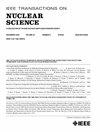高性能4H-SiC α粒子探测器精确TCAD仿真模型
IF 1.9
3区 工程技术
Q3 ENGINEERING, ELECTRICAL & ELECTRONIC
引用次数: 0
摘要
为了在计算机辅助设计(TCAD)模拟器中精确模拟4-六方碳化硅(4H-SiC)肖特基势垒二极管(SBD) α粒子探测器的最新实验I-V和电荷收集效率(CCE),进行了系统的校准过程。首先,通过调整肖特基金属功函数、迁移率和饱和速度,对模拟正演I-V进行验证。传统的势垒降低(BL)和非局部隧穿(NLT)模型低估了反向I-V。经过几次迭代,通过激活非局部陷阱辅助隧道(TAT)模型,使深度受体陷阱${Z} _{1/2}$在${E} _{C}$ -0.73 eV下完美匹配反向I-V。另一方面,在${E} _{C}$ -0.19 eV处使用其他无处不在的Ti陷阱的TAT模型高估了漏电流,这表明正确的陷阱选择是建立TAT电流模型的必要条件。将从物质中离子(SRIM)工具中提取的线性能量传递(LET)数据整合到重离子(HI) TCAD模型中,用于模拟CCE。默认的HI模型主要只预测探测器中漂移引起的电荷贡献,低估了低电压下CCE的扩散成分。因此,考虑在整个电压范围内匹配CCE的新型HI TCAD模型,其中包括导致CCE的漂移和扩散感应瞬态电流。本文还报道了温度引起的CCE变化。本文章由计算机程序翻译,如有差异,请以英文原文为准。
Accurate TCAD Simulation Model for High-Performance 4H-SiC Alpha-Particle Detectors
A systematic calibration procedure is carried out to accurately model the state-of-the-art experimental I–V and charge collection efficiency (CCE) of a 4-hexagonal silicon carbide (4H-SiC) Schottky barrier diode (SBD) alpha-particle detector in the technology computer-aided design (TCAD) simulator. At first, the simulated forward I–V is validated by adjusting the Schottky metal work function, mobility, and saturation velocity. The conventional models, such as barrier lowering (BL) and nonlocal tunneling (NLT), underestimate the reverse I–V. After several iterations, the reverse I–V is perfectly matched by activating the nonlocal trap-assisted tunneling (TAT) model with the deep-level acceptor trap ${Z} _{1/2}$ at ${E} _{C}$ –0.73 eV. On the other hand, employing the TAT model with other omnipresent Ti traps at ${E} _{C}$ –0.19 eV overestimates the leakage current, indicating that the proper trap selection is necessary to model the TAT current. The linear energy transfer (LET) data extracted from the stopping and range of ions in matter (SRIM) tool is incorporated in the heavy-ion (HI) TCAD model for simulating CCE. The default HI model predominantly predicts only drift-induced charge contributions in the detector and underestimates the diffusion component of CCE at low voltages. Thus, a novel HI TCAD model is considered to match the CCE in the entire voltage range, which includes both drift- and diffusion-induced transient currents contributing to the CCE. The temperature-induced variations in the CCE are also reported.
求助全文
通过发布文献求助,成功后即可免费获取论文全文。
去求助
来源期刊

IEEE Transactions on Nuclear Science
工程技术-工程:电子与电气
CiteScore
3.70
自引率
27.80%
发文量
314
审稿时长
6.2 months
期刊介绍:
The IEEE Transactions on Nuclear Science is a publication of the IEEE Nuclear and Plasma Sciences Society. It is viewed as the primary source of technical information in many of the areas it covers. As judged by JCR impact factor, TNS consistently ranks in the top five journals in the category of Nuclear Science & Technology. It has one of the higher immediacy indices, indicating that the information it publishes is viewed as timely, and has a relatively long citation half-life, indicating that the published information also is viewed as valuable for a number of years.
The IEEE Transactions on Nuclear Science is published bimonthly. Its scope includes all aspects of the theory and application of nuclear science and engineering. It focuses on instrumentation for the detection and measurement of ionizing radiation; particle accelerators and their controls; nuclear medicine and its application; effects of radiation on materials, components, and systems; reactor instrumentation and controls; and measurement of radiation in space.
 求助内容:
求助内容: 应助结果提醒方式:
应助结果提醒方式:


